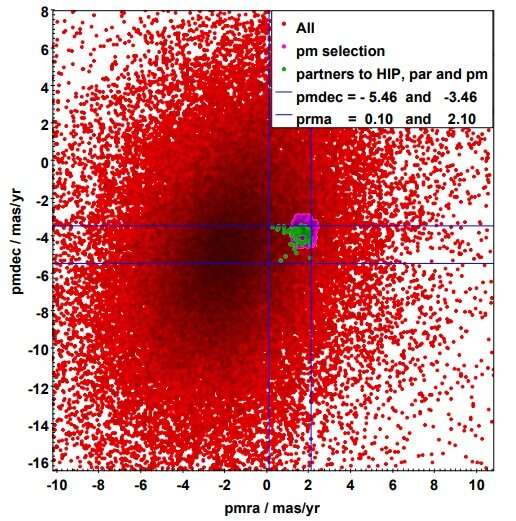September 18, 2019 report
New open cluster discovered using Gaia

Using data from ESA's Gaia satellite, German astronomers have detected a new open cluster in the Milky Way galaxy. The newly found cluster, designated Gaia 8, consists of about 100 stars, most likely including the Beta Lyrae variable. The finding is reported in a paper published September 10 on the arXiv pre-print server.
Open clusters, formed from the same giant molecular cloud, are groups of stars loosely gravitationally bound to each other. So far, more than 1,000 of them have been discovered in the Milky Way, and scientists are still looking for more, hoping to find a variety of these stellar groupings. Expanding the list of known galactic open clusters could be crucial for improving the understanding of the formation and evolution of the Milky Way.
Now, Ulrich Bastian of Heidelberg University in Germany reports the finding of a new galactic open cluster. Based on the data from Gaia Data Release 2 (DR2), he identified dozens of stars around Beta Lyrae that might be connected to the variable.
"Checking the relevant data in DR2 surprisingly revealed an open star cluster of around 100 members to which β Lyrae obviously belongs," Bastian wrote in the paper.
According to the study, Gaia 8 includes about 100 stars and is centered on Beta Lyrae. The results suggest that the newfound cluster belongs to a larger old star formation complex. This complex most likely includes two already known star clusters (ASCC 100 and Stephenson 1) and an extended strewn field of stars.
Bastian assumes that Beta Lyrae is a member of Gaia 8, noting few results that seem to confirm this assumption. For instance, the cluster is perfectly centered on Beta Lyrae on the sky, which suggests that it is by far its heaviest member. Moreover, the proper motion of Gaia 8 is fully consistent with the motion of Beta Lyrae provided by ESA's Hipparcos satellite, and mean parallax of the candidate members turned out to be practically equal to the Hipparcos value for this variable.
Beta Lyrae itself is an interesting target for observations as it could help unsolved some astrophysical mysteries. The system is a prototype of evolved semi-detached binaries with strong mutual gravitational deformation of the components, with mass transfer, significant period evolution and occasionally an accretion disk around the receiving companion.
The studies like the one authored by Bastian could shed more light on the nature of Beta Lyrae and other objects of this type. Further investigation of the Gaia 8 cluster could also be helpful in order to advance knowledge about such variables.
"The scientific motivation for deeper investigations will, on the one hand, be given by the astrophysical interest in β Lyrae itself. Using precise multi-color photometry in combination with high-quality spectroscopy of a small number of bright single-star members, or, for example, asteroseismology of just one or two bright members, can give solid estimates of the age and metallicity of the cluster. This in turn will provide a very useful asset for an improved astrophysical interpretation of the model binary β Lyrae and its kin," Bastian concluded.
More information: U. Bastian. Gaia 8: Discovery of a star cluster containing beta Lyrae—and of a larger old (extinct) star formation complex surrounding it. arXiv:1909.04612v1 [astro-ph.SR]: arxiv.org/abs/1909.04612
© 2019 Science X Network



















